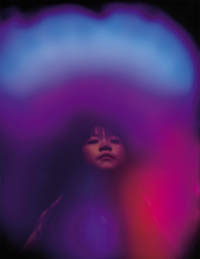|
In her ambitious Aura Project, Chrysanne Stathacos acts as an aesthetic and esoteric hunter-gatherer, collecting specimens of human auras with a specially-adapted instant camera designed to measure a person's electromagnetic energy through hand sensors. This conceptual work borders on performance art and recalls pseudo-scientific investigations that surrounded spirit mediums and other extrasensory events.
Stathacos's inspiration is derived from sources from the turn of the last century, when science and the Occult enjoyed a closer kinship. Advances in science at the time baffled layman and scientist alike, lending credence to the belief that the atmosphere was riddled with phenomena beyond human perception and ken. In books such as Thought Forms (1901) and Man Visible and Invisible (1902), Theosophists Annie Besant and Charles Leadbeater outlined a world beyond our sight with charts and graphs, greatly influencing artists. Stathacos's piece is awash in a spectrum of colors and arranged accordingly; each hue corresponds to a symbolic interpretation of the person's psyche or emotional state.
An internationally-exhibited artist, Stathacos is best known for her interactive, public art installations that look to Eastern traditions—from rose mandalas to wishing trees—for inspiration. One piece, The Wish Machine developed in concert with Creative Time, was a vending machine that dispensed photocollages and essential plant oils corresponding to a person's wish. An artist's book, Invisible Colors, published by Nature Morte accompanies The Aura Project as well as an interactive website hosted by Japan's Candy Factory. |
|

Chrysanne Stathacos, Nara, Japan, 2001, from The Aura Project, 2001, Polaroid, Courtesy of the artist
Click on the image for a larger version. |
| 
Artist Statement
For the past three years I have traveled around the world using a biofeedback camera taking "aura photographs" of spiritual people. Since the Theosophists, Ralph Steiner, and Nikola Tesla there has been an interest by artists and scientists to capture the "aura". Color theories based on these spiritual/scientific ideas and experiments had a profound influence on the modernists in the early 20th century, which formed the basis for how we look at and feel about color today. These ideas influenced me to embark on this project one hundred years later to investigate creatively how our relationship to color has transformed with new technologies.
During the past three years I have taken 700 aura photographs of people from different ethnic, and spiritual traditions around the world. These portraits are of sadhus and holy women by the Ganges in Rishikesh, India, Tibetan refugees in the mountains of Dharamsala, Buddhist monks and dancers in the hills of Kyoto, Sikh families in Long Island and artists in New York, Germany and Canada (and I am still in process photographing). The biofeedback camera registers reads the thermal electrical touch from the body, which is transmitted into a small computer in the camera. The final result is a portrait engulfed in color. |
|